Location: Denmark
Editor’s Note: For readers unfamiliar with Interface Theory, I would like to provide a brief context for Tina Mariane Krogh Madsen’s intervention. Interface Theory has been described as an approach to questions of the human relationship to technology, with the interface variously defined as a multiplicity of processes, as unfolding interactions, and/or as mediated relations. Interface theory threads through media theory, information theory, cybernetics, human-computer interaction, game theory, political theory, network theory, and other philosophical and critical theory trajectories. For a better understanding of Interface Theory, please see references at the end of this essay.
I. INTRODUCTION
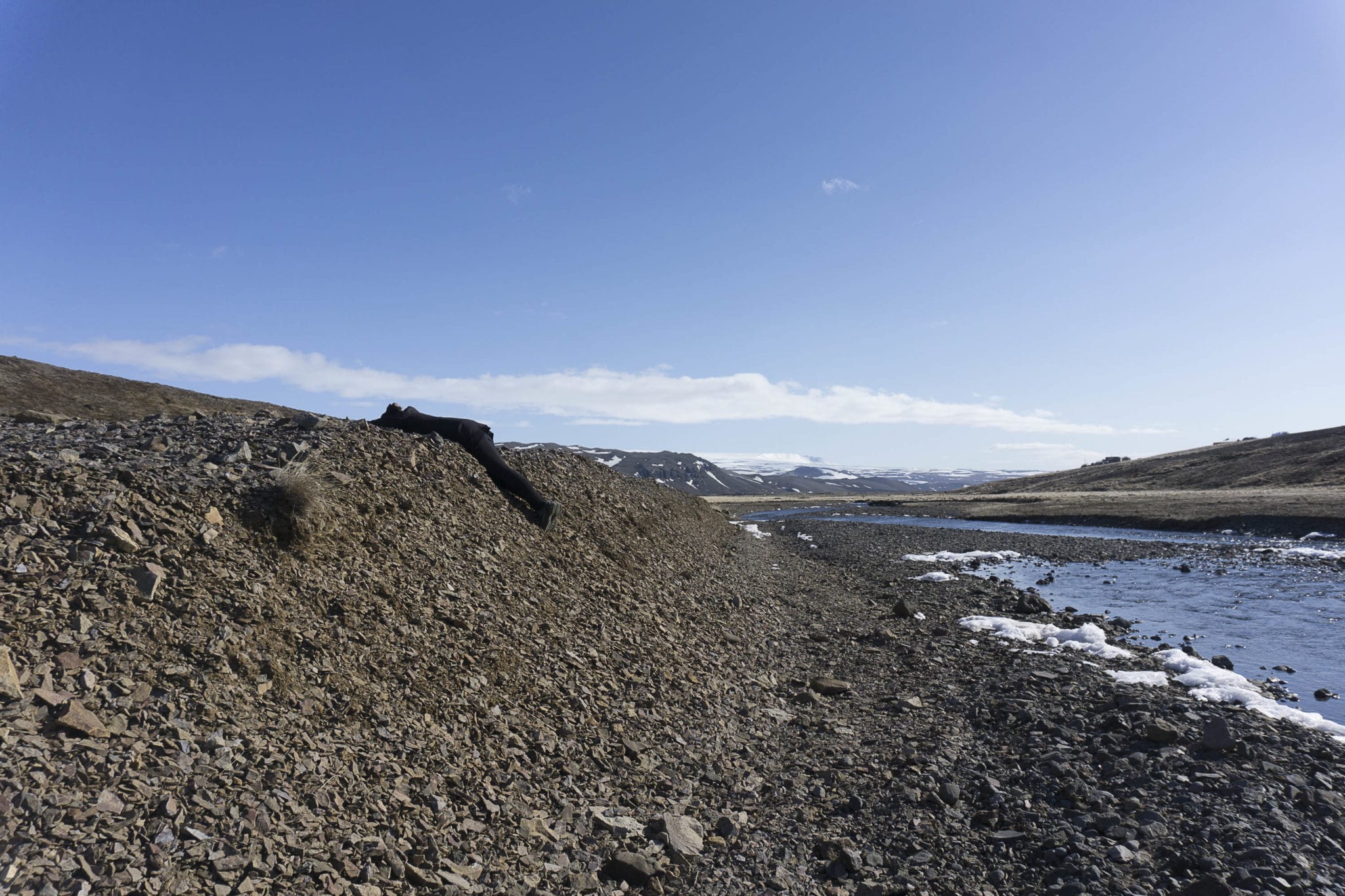
BODY INTERFACES INTERVENTIONS IN LANDSCAPE I, Tina Mariane Krogh Madsen, FljoÌtstunga Residency, 2015. Photo credit: Cecilia Bona.
BODY INTERFACES IS AN artistic performance research that combines working with the body as a materiality in itself, in the tradition of site-specific performance art, with an understanding of its interactive potentials inspired by the technological methodologies of the interface.
I developed this concept from my long artistic work with body, textures and identity, together with extensive theoretical research in net-based practice, embodiment, sensation, and affect. This combination of knowledge produced in the intersection of these fields became the backdrop of the project.
II. BODY AS INTERFACE
IN BODY INTERFACES, the interface is inscribed in the body’s relation to the environment and the kinship that is created through this process. The body is an embodied technology in itself. It goes beyond the body/machine dichotomy that has been an essential part of contemporary media theory, aiming instead for a representation and understanding of the interface as a crucial part of experiencing and sensing in everyday life (Madsen 2016).
Underlying this work is a wish to expand, highlight, and discuss the status of the body in interface theory. To an extent this has been practiced in contemporary media discourse, for example by media theorist Anna Munster and her reflections on digital embodiment, which turn away from the binary Cartesian splits so often forced upon interface theory. Munster requests an expansion of the field to also include the body (Munster 2006). While dealing in depth with this topic, Munster doesn’t take a full step away from the machine, still connecting this to the body in her definition.
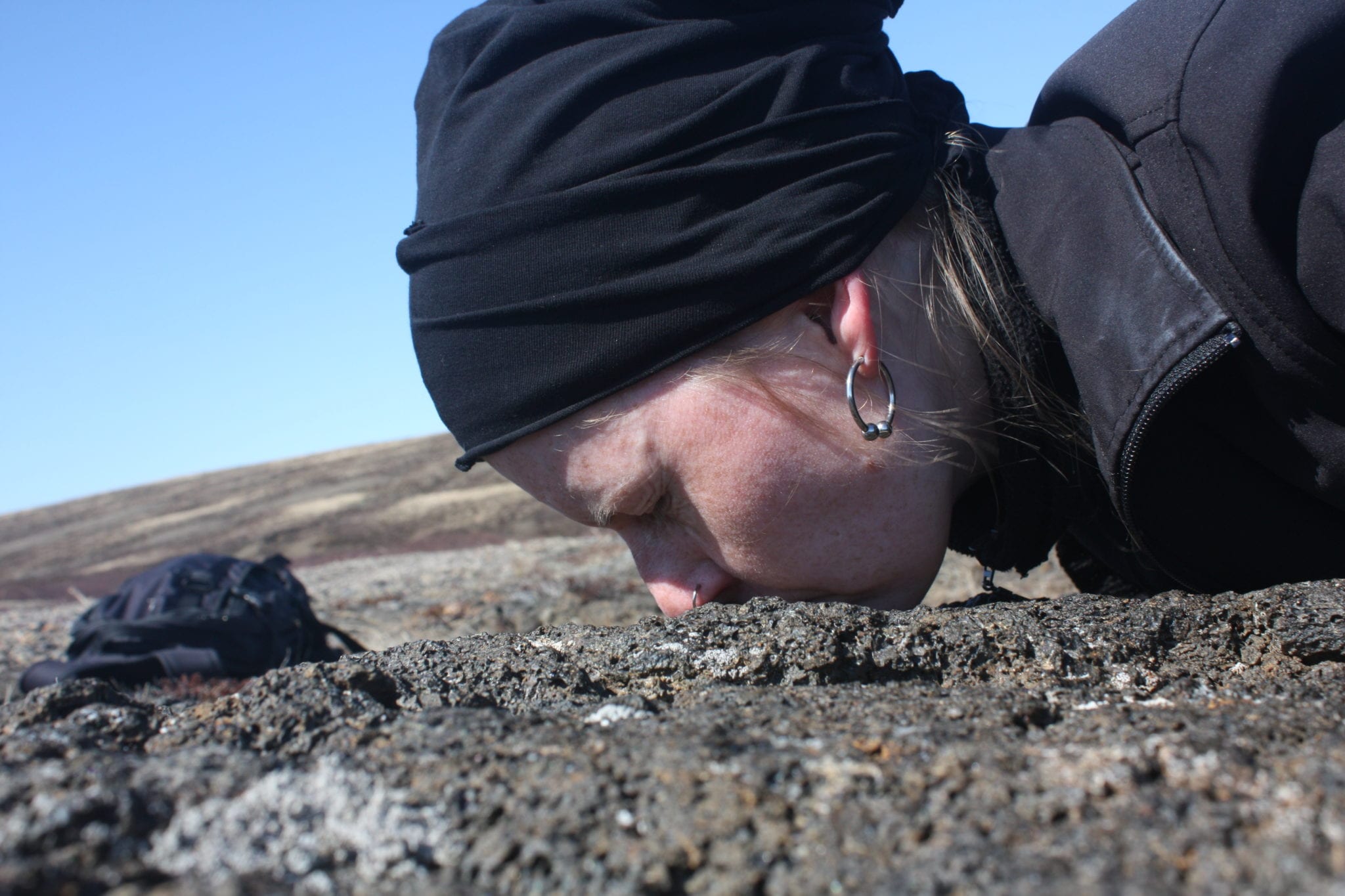
BODY INTERFACES- EXPERIMENT #4/ Hallmundarhraun, Tina Mariane Krogh Madsen, FljoÌtstunga Residency, 2015.
The first step to move away from this automatic anchoring – and distinction – of body and machine, is to take the focus away from the screen. Cultural theorist Branden Hookway embraces this challenge by reflecting on the ontology of the interface from a cultural perspective. Hookway explains the interface as ‘a between faces and a facing between’ (Hookway 2014), dealing directly with the action that is taking place in the interface encounter. The Body Interfaces concept works in this space, regarding the body as a technology in itself. In line with the thoughts of literary critic N. Katherine Hayles, the contemporary body is also post-human, as ‘the original prosthesis we all learn to manipulate’ (Hayles 1999: 3). This nods to parts of feminist theorist Donna Haraway’s seminal Cyborg Manifesto (1984) that characterize the body as a fluid entity, where change and transformation are possible.
The political philosopher, cultural theorist, and artist Erin Manning, like Hayles, sees the original technicity and prosthetic nature of the body as central, with the sensing body as a post-human (critical) body that engages creatively with what a body makes possible (Manning 2006). This approach relates theoretically to political philosopher Brian Massumi’s concept of the abstract body in excess of itself (Massumi 2002) that facilitates an affective political body through movement and invention.
III. BODY AND SENSES AS MEDIATORS
‘THE BODY AS INTERFACE’ in this context means to be able to use the sensuous apparatus in interaction with other agents, textures, and environments. The senses function as mediators for experience, giving and collecting information based on the structures that they interact with. It is these receptors that enable a threshold experience to take place, where the body is in dialogue with place.
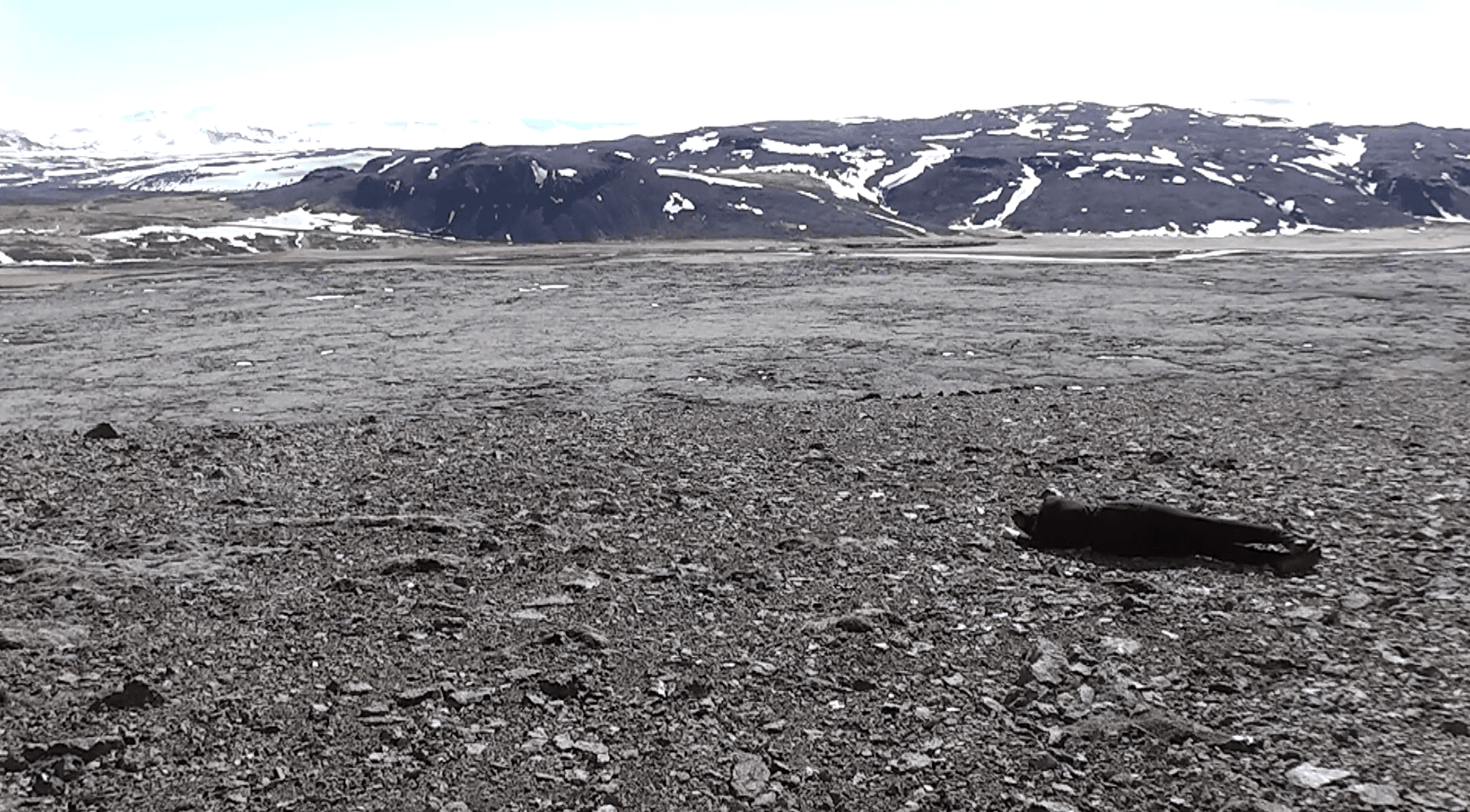
BODY INTERFACES- EXPERIMENT #2, Tina Mariane Krogh Madsen, FljoÌtstunga Residency, 2015.
To fully engage in the threshold experience of the exchange, the sensuous apparatus must be included in the interaction.
Geographer Paul Rodaway formulates how the representation of sensuous experience is connected to the culture where it is performed. The senses are in a relationship to the world, with the body a crucial part of social, political, historical, and geographical experience. Rodaway sees the interface potential of the skin as a mediator between the body and the surrounding environment, with sensory receptors that receive information about the outside parameters. The skin is an organ that relates to the outside environment (Rodaway 1994). These reflections are crucial when engaging and using the body in direct contact with environments, where factors such as wind, cold, pain, are evident. These are data that the Body Interface interventions collect, use, and transform.
IV. BODY AS SITE-SPECIFIC ACTANT
SITE-SPECIFICITY IS AN essential part of the research. Each intervention or performance is anchored by the place of action. The characteristics of the place are deciphered and relational properties are investigated through interaction. The elements of the site become both departure point and data-feeder for the performances. It is not the visual qualities of the actions that are the main focus points in these interventions, but the engagement with(in) a chosen place.
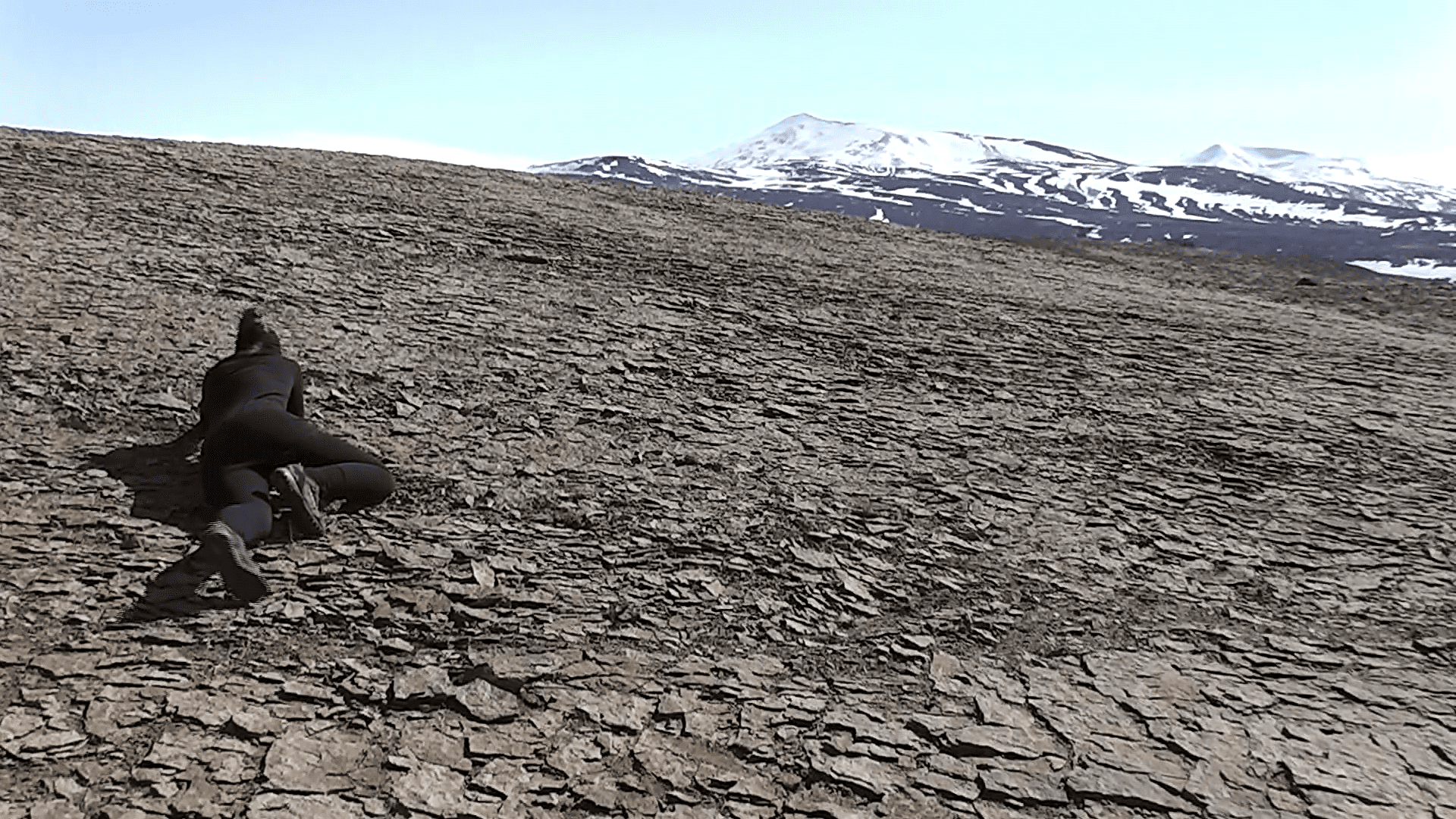
BODY INTERFACES- EXPERIMENT #3,Tina Mariane Krogh Madsen, FljoÌtstunga Residency, 2015.
The Body Interfaces performances and interventions began in May 2015 in rural West Iceland, at the Fljótstunga artist residency. In conceptualizing the project, my wish was to create these first interventions specifically in Iceland due to the climate and intense encounters to be undertaken there, in a remote place with no public transport, as close as you could get to the center, before pure nature. The residency was two weeks long, and I wanted to interact with all the different elements in the landscape, stones of various sorts (basalt, lave stone), snow, dried grass (hay). I created imprints on paper with the different variations of stone surfaces as registrations and testimonies of agency. All interactions were noted down afterwards, which was impossible to do on site when performing due to the strong winds on most days of the residency.
The following is an example of the first Body Interfaces registrations that also created the basis for the next performances, future field-notations, and the Body Interfaces actions script.
Location: Fljótstunga, West Iceland, Sandfjöll (Sand Mountains). Date: 04.05.2015
Process description: The wind is very cold and stormy, it is hard to walk in the landscape due to the resistance of the wind. The chill factor is very high. The spot for the experiment is chosen. Due to the intensity of the wind, assistance with the documentation is needed. The performer wears tight black clothes made out of cotton (not wind proof), no jacket, no gloves or scarf, which makes the experiment even colder and more intense. The performer slowly crawls and slides up over Sand Mountain’s sharp surface of stones. The movement is choreographed by the formation of the surface, where potential obstacles have an impact on the direction of the body. The soundscape is a combination of the intensity of the wind as well as the ceramic sounds of the cracking stones of the mountain. Nothing is planned beforehand, only the location. The act is video recorded in one take.
Parameters that affect the intervention and the entities involved:
Temperature of the environment (the surface, the wind, weather): Stormy cold wind, turbulence (minus degrees in the wind) affect the body temperature and movements of the performer.
Temperature of the body (can also potentially affect the surface): In this case the body can only interact with the placement of the stones, the body temperature doesn’t affect the stones in return.
Different movements can affect both entities involved dependent on the characteristics of each surface entity: the contact between the very sharp stones of the Sand Mountain and the body sliding over these.
Results: Pain (because of the sharp stones); Numbness (due to the cold wind); Marks on the body (blue marks and scratches).’
The interactions in Iceland have an inscribed focus on environment and climate change, with respect for nature, which is a defining line in the current state of the art of the research.
In all the Body Interfaces interventions the relation between human and non-human entities are important, because of a critical and new materialist approach to intervention and ecology. They are informed by feminist theorist Karen Barad (2003, 2007), political science professor Jane Bennett (2010), and philosopher, anthropologist and sociologist Bruno Latour (2004), amongst others. Dynamic intra-active relations are activated between human and non-human actants, each having an equal part in the dialogue taking place.

BODY INTERFACES- EXPERIMENT #1/ imprint in snow, Tina Mariane Krogh Madsen, FljoÌtstunga Residency, 2015.
In the fall/winter of 2015 I returned to Iceland to do further research, this time living in the town of Seyðisfjörður on the east coast for two months. I started to create scores for movement in relation to the mountains that surround the place, raising themselves around the fjord. The scripts and interactions were all a relational practice created in dialogue with nature. Through their pure existence, in a dialogue and relation, the mountains activate their ‘thing-power’ for the performer to respond to.
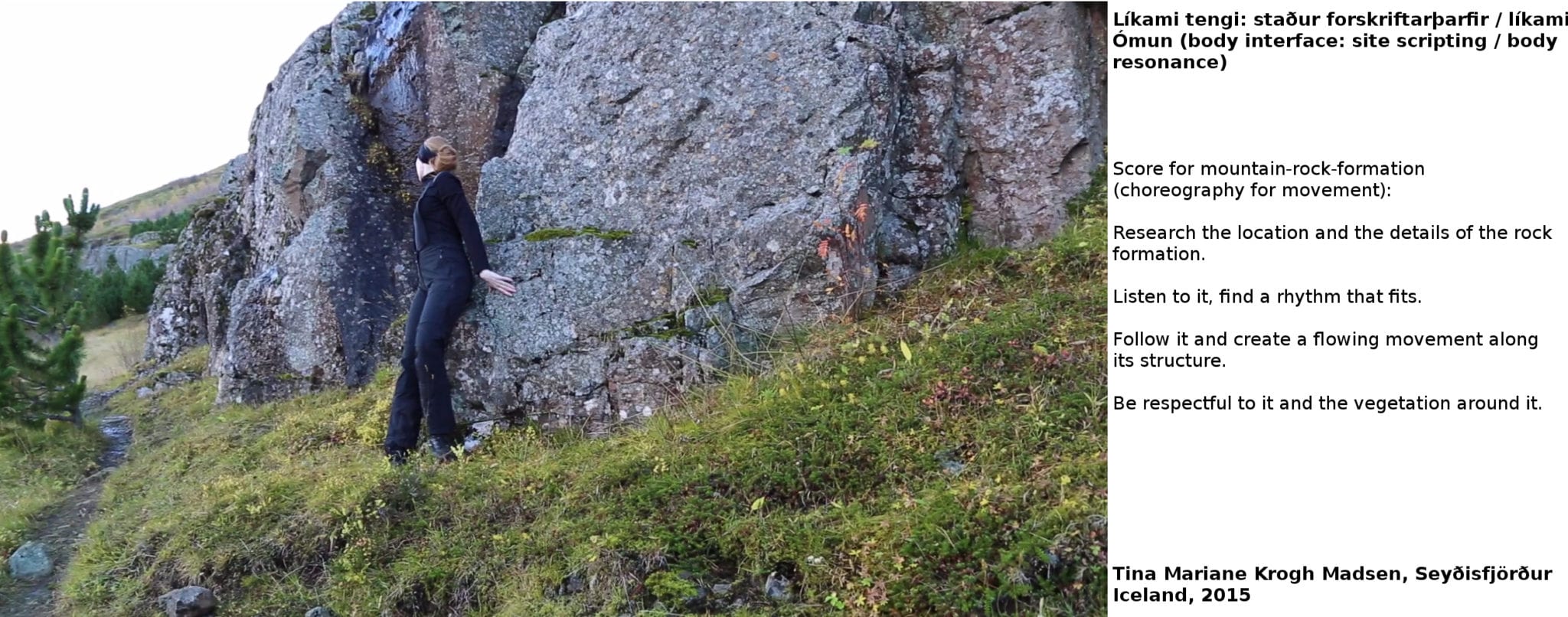
BODY INTERFACES SITE INSTRUCTION, Tina Mariane Krogh Madsen, Seydisfjordur, 2015. Photo credit: Malte Steiner.
V. BODY AS CELL-DRIVEN TECHNOLOGY
THE NOTION OF MEDIATION is interesting when performing in climates where the senses are constantly challenged. The body and its cells are exposed to changes and interventions in their current states. An example is the above mentioned Body Interfaces Sandfjöll, where the surface interacted with consisted of layers of flat sharp stone, which together with ice and cold wind created an intense affective relation. In general, when creating and placing the body in contact with different surfaces, the responses are unpredictable and cannot be planned beforehand. The same happens when performing with mountains, their surfaces and sharp stones affect the interaction taking place.
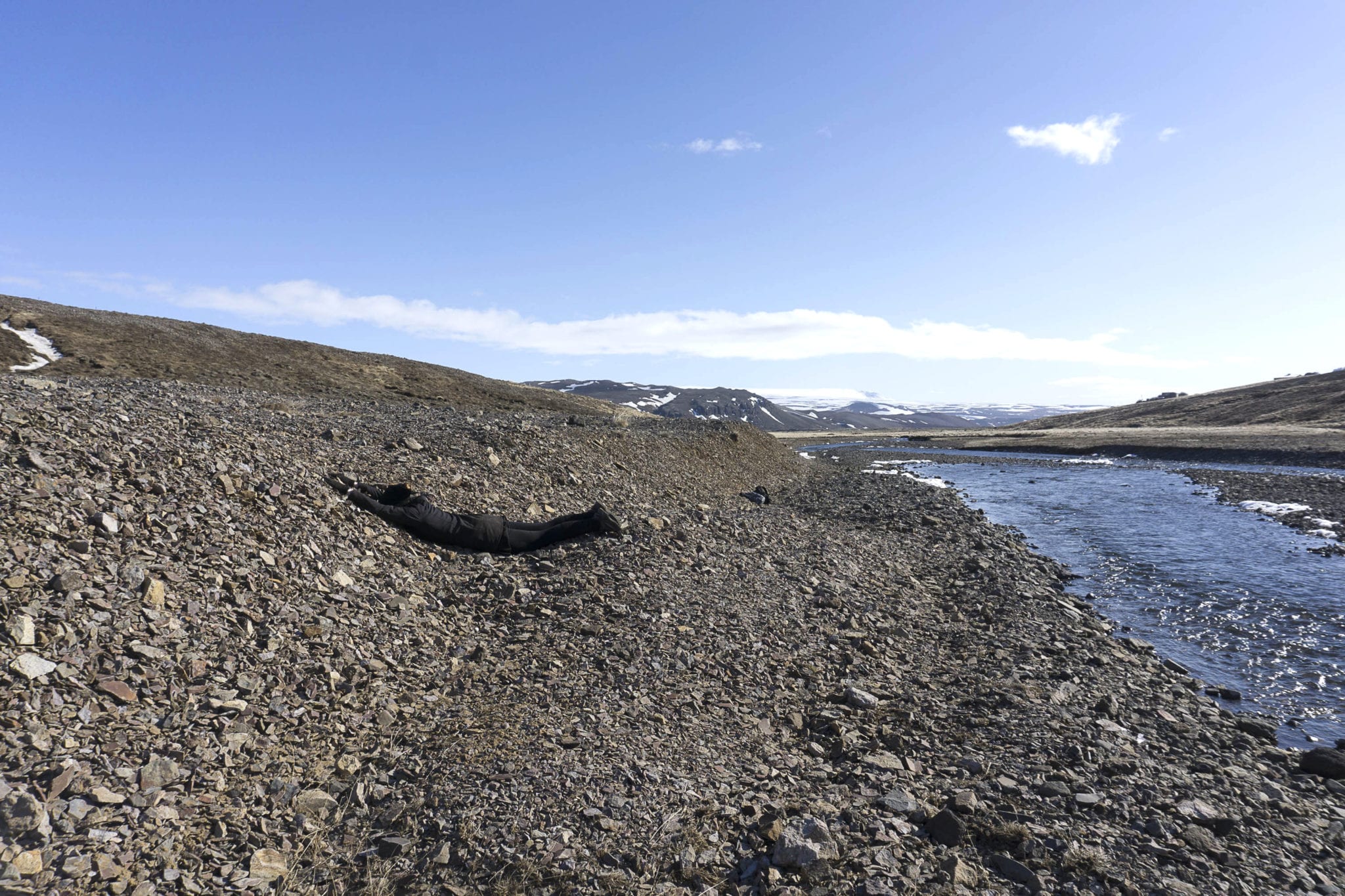
BODY INTERFACES INTERVENTIONS LANDSCAPE II, Tina Mariane Krogh Madsen, Fljótstunga Residency, 2015. Photo credit: Cecilia Bona.
VI. BECOMING…
THE BODY IN RELATION is also a body in becoming, it goes from state to state in the flow of the moment. As a performer it is important to go beyond the pure relation to place by using the movements, and minor variations of these, to become one with the environment, engaging in an affective exchange. In my current research in affect, environment, and the body, the assemblage thinking of philosopher Gilles Deleuze & psychotherapist, philosopher, and activist Felix Guattari are important. In this context I want to emphasize their concept of becoming through movement:
‘Movement has an essential relation to the imperceptible; it is by nature imperceptible. Perception can grasp movement only as the displacement of a moving body or the development of a form. Movements, becomings, in other words, pure relations of speed and slowness, pure affects, are below and above the threshold of perception.’ (Deleuze & Guattari, A Thousand Plateaus 1980[1987])
This relation of positioning the body, its movement in relation to place, activates the Spinozean ability to affect and be affected. This force and energies are parts of creating the affective assemblages that are crucial in environmental performance art, and in Body Interfaces in particular. What a body can do – can also be said as what a body can sense – or affect (or be affected by)?
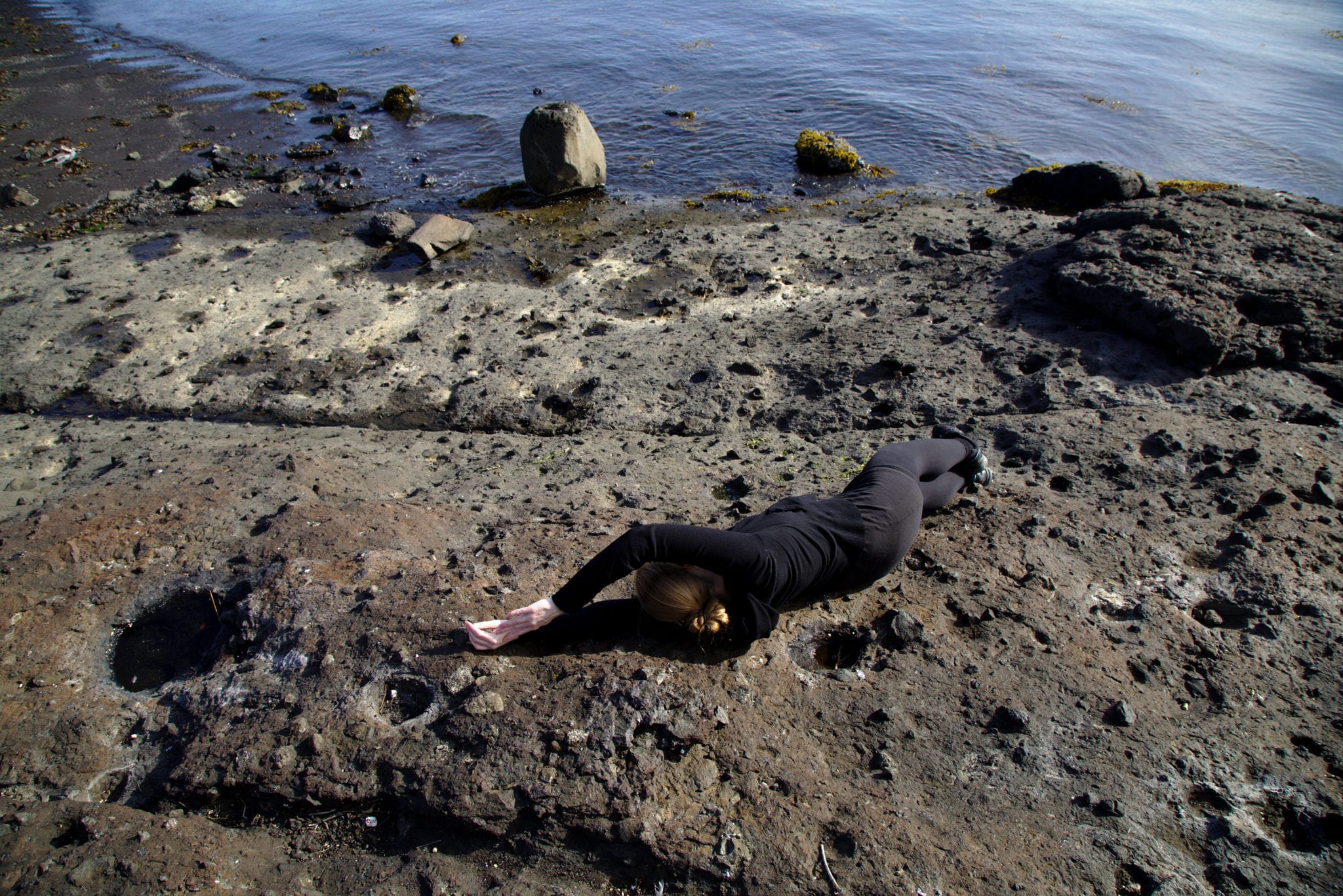
BODY INTERFACES ENVIRONMENTS II, Tina Mariane Krogh Madsen, Viðey Iceland, 2017. Photo credit: Malte Steiner.
The assemblage is the engagement between the performing body, the stones, the environment and weather. The above mentioned performances and interventions include sensuous experience and affect as crucial elements in actions that facilitate the body in becoming environment. It embraces the capacities to be affected by other (non-human) bodies, actants. It responds beyond its physical borders and the becoming with is a becoming together – a collective organism that responds to each others presence creating a threshold relation and experience. The mentioned examples of performance work are examples of affective assemblages through their becoming-with – becoming-environment.
VII. CHALLENGING SPACES
THE BODY INTERFACES RESEARCH has expanded over time to include more cultural settings with the aim to apply the mentioned strategy to new settings, and to challenge the formats, and explore the different sensations of interaction. Performances were tested in more cultural contexts, e. g. at the Electropixel Festival in Nantes (FR), the Pixel Festival in Bergen (NO), the Sofia International Performance Art Festival (BG), as well as performative installations and workshops were created. The installations contained archival material from previous performances and interventions and were created at the performance space Grüntaler9 in Berlin (DE), as well as the project Space Spanien 19C in Aarhus (DK). It is important to mention that the concept itself was very dedicated to its own form and limitations and therefore also selected specific settings that could embrace the topic. Here additional issues relating to the role of the archive in artistic research became evident, the status of documentation, and re-performance as a strategy.
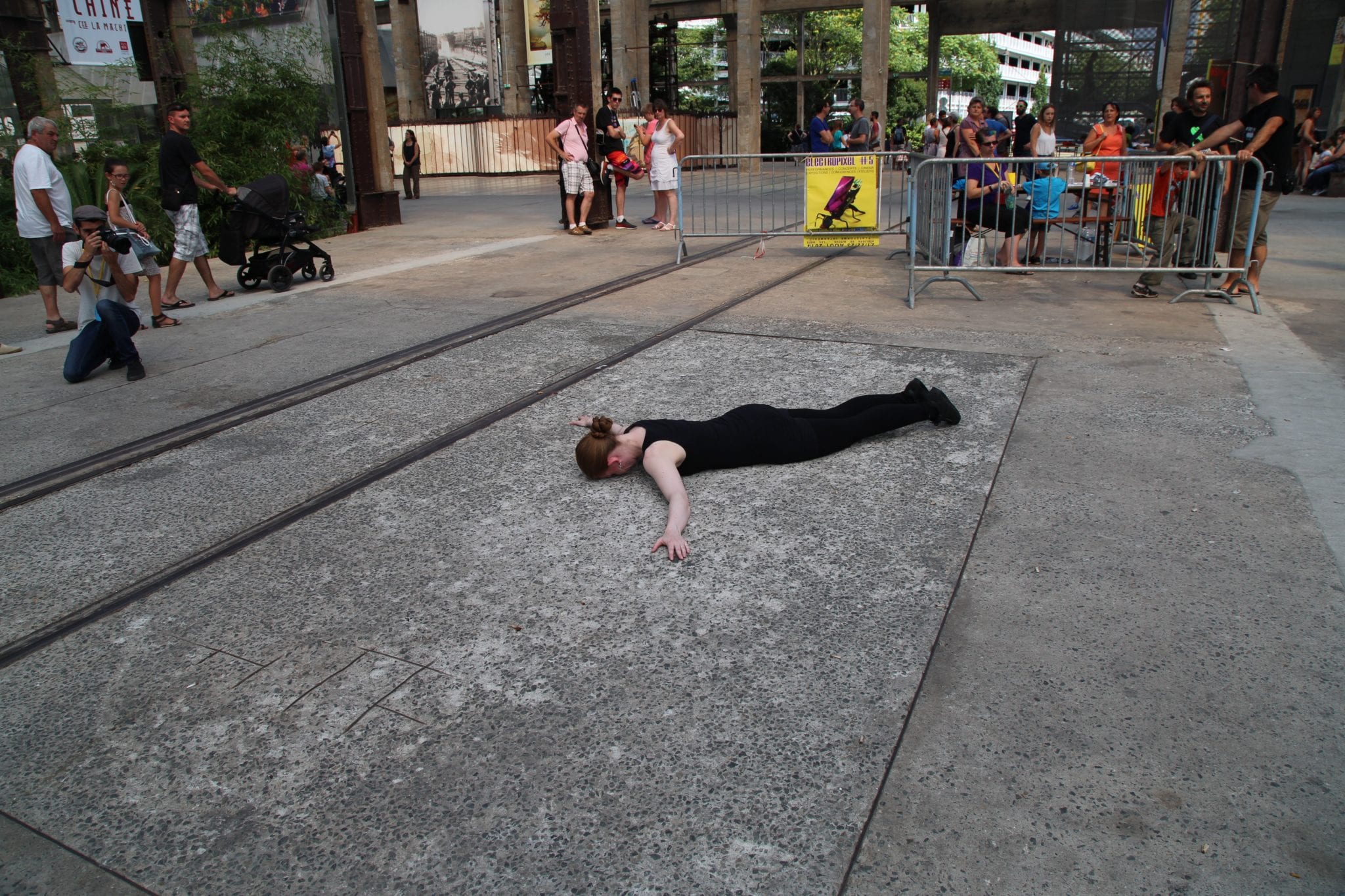
BODY INTERFACES URBAN DISRUPTION, Tina Mariane Krogh Madsen. Electropixel, Nantes, France 2015. Photo credit Malte Steiner
To sum up, the Body Interfaces concept sees the body as a cell-driven technology that can be used to gather information about the environment. It can be used for threshold experiences and surface sample-taking in a practice of data mining with the body. Body Interfaces wishes to challenge and incorporate specific formats and terminologies inherent from technology and scientific practices; creating a DIY, open and analogue approach. It is a sensuous and affective research.
Even though trying out the format in other settings, the environmental focus will always be the most essential, and which to a higher degree also will be the main focus in the future development of performances and interventions to appear within this context.

BODY INTERFACES WORKSHOP, Tina Mariane Krogh Madsen, Arts in the Environment, Helsinki 2017. Photo credit: Hege Tapio.
END NOTES:
For more information on Interface Theory, please visit Interface Critique
BARAD, Karen (2007). Meeting the Universe Halfway: Quantum Physics and the Entanglement of Matter and Meaning, Durham: Duke University Press, 2007.
BENNETT, Jane (2010). Vibrant Matter: A Political Ecology of Things. Durham: Duke University Press, 2010.
DELEUZE, Gilles & GUATTARI, Felix (1980). A Thousand Plateaus: Capitalism and Schizophrenia. Trans. Brian Massumi. Minneapolis: University of Minnesota Press, 1987.
HARAWAY, Donna (1985). ‘A manifesto for cyborgs: Science, technology, and socialist feminism in the 1980s.’ Socialist Review 5(2), 1985. pp.65-107.
HAYLES, Katherine N. (1999). How We Became Posthuman – Virtual Bodies in Cybernetics, Literature, and Informatics. Chicago/London: The University of Chicago Press, 1999.
HOOKWAY, Branden (2014). Interface, Cambridge MA: The MIT Press, 2014.
LATOUR, Bruno (2004) Politics of Nature: How to Bring the Sciences into Democracy. Massachusetts: Harvard University Press, 2004.
MADSEN, Tina Mariane Krogh (2016). ‘Body Interfaces – Contesting Agency.’ In MARTÃNEZ, T. and MARZO, J.L. (eds.) Interface Politics: 1st International Conference. GREDITS Publication 04, Barcelona: Bau, Centre Universitari de Disseny & Hangar.org, pp. 343-360, 2016.
MANNING, Erin (2006). The Politics of Touch – Sense, Movement, Sovereignty, Minnesota: University of Minnesota Press, 2006.
MASSUMI, Brian (2002). Parables for the Virtual, Durham/London: Duke Uni Press, 2002.
RODAWAY, Paul (1994). Sensuous Geographies: Body, Sense and Place. London: Routledge, 1994.
